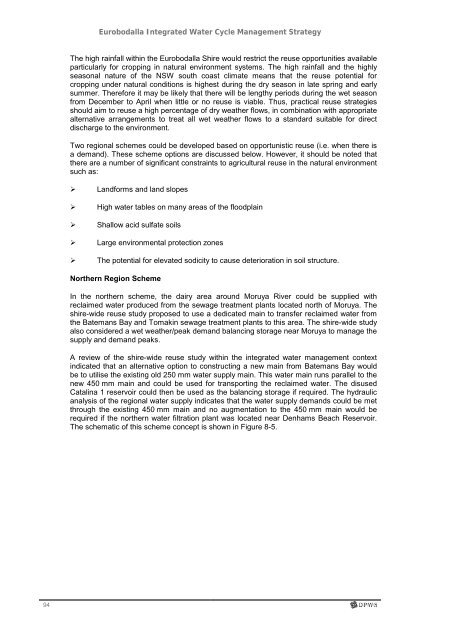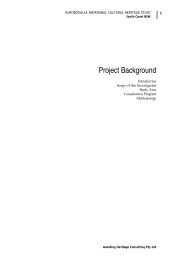Eurobodalla Integrated Water Cycle Management Strategy
Eurobodalla Integrated Water Cycle Management Strategy
Eurobodalla Integrated Water Cycle Management Strategy
Create successful ePaper yourself
Turn your PDF publications into a flip-book with our unique Google optimized e-Paper software.
94<br />
<strong>Eurobodalla</strong> <strong>Integrated</strong> <strong>Water</strong> <strong>Cycle</strong> <strong>Management</strong> <strong>Strategy</strong><br />
The high rainfall within the <strong>Eurobodalla</strong> Shire would restrict the reuse opportunities available<br />
particularly for cropping in natural environment systems. The high rainfall and the highly<br />
seasonal nature of the NSW south coast climate means that the reuse potential for<br />
cropping under natural conditions is highest during the dry season in late spring and early<br />
summer. Therefore it may be likely that there will be lengthy periods during the wet season<br />
from December to April when little or no reuse is viable. Thus, practical reuse strategies<br />
should aim to reuse a high percentage of dry weather flows, in combination with appropriate<br />
alternative arrangements to treat all wet weather flows to a standard suitable for direct<br />
discharge to the environment.<br />
Two regional schemes could be developed based on opportunistic reuse (i.e. when there is<br />
a demand). These scheme options are discussed below. However, it should be noted that<br />
there are a number of significant constraints to agricultural reuse in the natural environment<br />
such as:<br />
Landforms and land slopes<br />
High water tables on many areas of the floodplain<br />
Shallow acid sulfate soils<br />
Large environmental protection zones<br />
The potential for elevated sodicity to cause deterioration in soil structure.<br />
Northern Region Scheme<br />
In the northern scheme, the dairy area around Moruya River could be supplied with<br />
reclaimed water produced from the sewage treatment plants located north of Moruya. The<br />
shire-wide reuse study proposed to use a dedicated main to transfer reclaimed water from<br />
the Batemans Bay and Tomakin sewage treatment plants to this area. The shire-wide study<br />
also considered a wet weather/peak demand balancing storage near Moruya to manage the<br />
supply and demand peaks.<br />
A review of the shire-wide reuse study within the integrated water management context<br />
indicated that an alternative option to constructing a new main from Batemans Bay would<br />
be to utilise the existing old 250 mm water supply main. This water main runs parallel to the<br />
new 450 mm main and could be used for transporting the reclaimed water. The disused<br />
Catalina 1 reservoir could then be used as the balancing storage if required. The hydraulic<br />
analysis of the regional water supply indicates that the water supply demands could be met<br />
through the existing 450 mm main and no augmentation to the 450 mm main would be<br />
required if the northern water filtration plant was located near Denhams Beach Reservoir.<br />
The schematic of this scheme concept is shown in Figure 8-5.

















